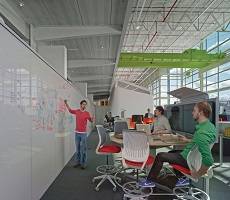July 28, 2014
A vision of office design that is the exact opposite of all it claims to be
 The currently voguish idea that ‘sitting kills’ finds an interesting interpretation in this conceptual office design by Dutch architects RAAAF and the artist Barbra Visser. Designed with the good intentions of encouraging movement, the hellish outcome has the aesthetics of a stealth bomber crossed with an underpass in Peterborough reimagined by MC Escher, the functionality and appeal of a Snowdonian potholing weekend and is populated by 21st Century hipsters and band members of Kraftwerk. This is the Outstanding Landscape of Affordances, commissioned by the Netherlands’ Chief Government Architect and set to become a real installation in Amsterdam next year. To be fair, the blurb does describe the idea as ‘a first step towards a future in which standing at work is the new norm’, but that doesn’t mean we should ignore its catastrophic shortcomings, even as a talking point.
The currently voguish idea that ‘sitting kills’ finds an interesting interpretation in this conceptual office design by Dutch architects RAAAF and the artist Barbra Visser. Designed with the good intentions of encouraging movement, the hellish outcome has the aesthetics of a stealth bomber crossed with an underpass in Peterborough reimagined by MC Escher, the functionality and appeal of a Snowdonian potholing weekend and is populated by 21st Century hipsters and band members of Kraftwerk. This is the Outstanding Landscape of Affordances, commissioned by the Netherlands’ Chief Government Architect and set to become a real installation in Amsterdam next year. To be fair, the blurb does describe the idea as ‘a first step towards a future in which standing at work is the new norm’, but that doesn’t mean we should ignore its catastrophic shortcomings, even as a talking point.






 Given the track record of people when it comes to making predictions about the future, it’s easy to grow cynical, especially when it involves a profession as subject to the vagaries of technological and cultural change as facilities management. But while we should be wary of more fanciful and long term thinking, any natural scepticism shouldn’t blind us to those predictions that we know will largely come true, especially those based on what we know is happening already. For example, recent research carried out by Cass Business School and Henley Business School and presented in the book
Given the track record of people when it comes to making predictions about the future, it’s easy to grow cynical, especially when it involves a profession as subject to the vagaries of technological and cultural change as facilities management. But while we should be wary of more fanciful and long term thinking, any natural scepticism shouldn’t blind us to those predictions that we know will largely come true, especially those based on what we know is happening already. For example, recent research carried out by Cass Business School and Henley Business School and presented in the book  The world of work and the workplace is always changing. We know it. You know it. In fact, there are a whole host of people that know it, but depending on what side of the professional fence you sit on, you might approach it in different ways, looking through a different lens or with a specific focus. Or are you already bridging the professional gap? Workplace change and the numerous ramifications of it are well documented. In a world that is changing, at frightening pace, it is strange to think that many of the ways in which we work are so entrenched in 20th century thinking. We need to break away from this and outline what the future is going to look like and how we should adapt. Or do we already have the answers? This ground is well trodden. However, it could be time to reassess our thinking and the way we approach this challenge, ensuring it becomes the norm for organisations around the world.
The world of work and the workplace is always changing. We know it. You know it. In fact, there are a whole host of people that know it, but depending on what side of the professional fence you sit on, you might approach it in different ways, looking through a different lens or with a specific focus. Or are you already bridging the professional gap? Workplace change and the numerous ramifications of it are well documented. In a world that is changing, at frightening pace, it is strange to think that many of the ways in which we work are so entrenched in 20th century thinking. We need to break away from this and outline what the future is going to look like and how we should adapt. Or do we already have the answers? This ground is well trodden. However, it could be time to reassess our thinking and the way we approach this challenge, ensuring it becomes the norm for organisations around the world.
 There is now an unstoppable energy for radical change in the way that companies of all sizes conduct their Corporate Social Responsibility duties. There are compelling economic and social reasons for companies to construct new ways of thinking and practice around CSR that go way beyond just doing something worthy or nice, from building effective partnerships to attracting top employees. Some companies prefer terms like ‘corporate responsibility’, ‘corporate conscience’, ‘corporate citizenship’, ‘social performance’, ‘sustainability’ or even ‘future-proofing’ over CSR. But the core CSR principles are that a business voluntarily commits to embracing responsibility for its actions and to impacting positively on the environment, on society and on consumers, employees and other stakeholders.
There is now an unstoppable energy for radical change in the way that companies of all sizes conduct their Corporate Social Responsibility duties. There are compelling economic and social reasons for companies to construct new ways of thinking and practice around CSR that go way beyond just doing something worthy or nice, from building effective partnerships to attracting top employees. Some companies prefer terms like ‘corporate responsibility’, ‘corporate conscience’, ‘corporate citizenship’, ‘social performance’, ‘sustainability’ or even ‘future-proofing’ over CSR. But the core CSR principles are that a business voluntarily commits to embracing responsibility for its actions and to impacting positively on the environment, on society and on consumers, employees and other stakeholders.  The recent Cabinet reshuffle in the UK Government won’t alter one fact; politicians simply don’t get it when it comes to technology, the workplace, the way people work and the needs of small businesses. Once you dismiss the paranoid idea that they DO get it but don’t care because they’re too busy looking out for The Man, you have to conclude that one of the big problems they have (this won’t go where you think) is that they don’t understand anything about technology and work, especially when it comes to emerging technology, the working lives of individuals, the needs and functions of small businesses and the fact the self-employed exist at all. These things exist outside the bubble. This is obviously a problem because they are implementing policies and making big, uninformed and anachronistic decisions about the things that shape every aspect of our lives, help to define us as people and determine how companies and individuals function. Here are just three examples.
The recent Cabinet reshuffle in the UK Government won’t alter one fact; politicians simply don’t get it when it comes to technology, the workplace, the way people work and the needs of small businesses. Once you dismiss the paranoid idea that they DO get it but don’t care because they’re too busy looking out for The Man, you have to conclude that one of the big problems they have (this won’t go where you think) is that they don’t understand anything about technology and work, especially when it comes to emerging technology, the working lives of individuals, the needs and functions of small businesses and the fact the self-employed exist at all. These things exist outside the bubble. This is obviously a problem because they are implementing policies and making big, uninformed and anachronistic decisions about the things that shape every aspect of our lives, help to define us as people and determine how companies and individuals function. Here are just three examples.
 Arthur C Clarke was one of those scientists and science fiction writers who made a pretty decent fist of getting his technological predictions right. Not only did he foretell general trends such as
Arthur C Clarke was one of those scientists and science fiction writers who made a pretty decent fist of getting his technological predictions right. Not only did he foretell general trends such as 









July 31, 2014
Yet another report into the Future of Work that is really about the present
by Mark Eltringham • Comment, Flexible working, Technology, Workplace design
(more…)